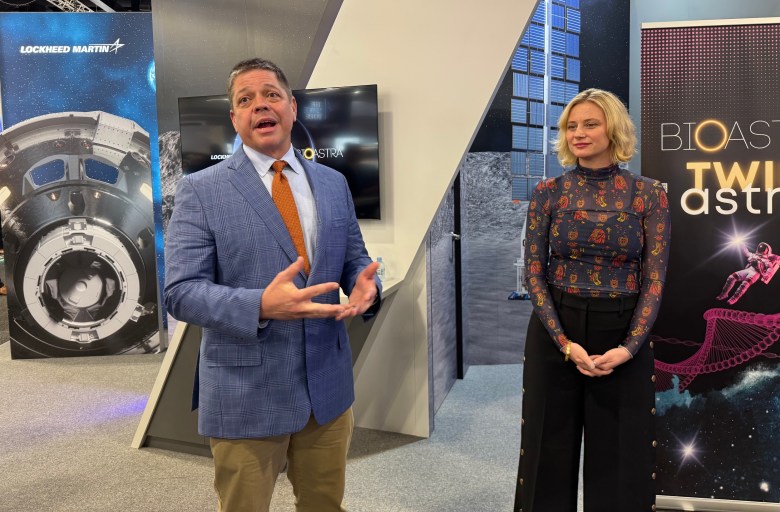[[{“value”:”
SYDNEY — An agreement to study a private astronaut mission using an Orion spacecraft is one of the first steps by Lockheed Martin in its efforts to offer the spacecraft as a service.
At the International Astronautical Congress here Sept. 30, Lockheed Martin announced an agreement with BioAstra, a nonprofit organization, to study flying a mission in Orion beyond Earth orbit to perform biomedical research.
The Twin Astra mission would be modeled on NASA’s Twins Study from a decade ago when astronaut Scott Kelly spent nearly a year on the International Space Station. Scientists compared physiological, molecular and other changes he experienced in space with his twin brother, Mark Kelly, who remained on the ground.
“This is the best natural experiment that biology gives us to use identical twins to understand what is truly happening to humans in space,” Savi Glowe, BioAstra’s chief executive, said at the announcement. “We will be working with Lockheed and starting to look into deep space, and so forming this collaboration now and working together in these early days is incredibly exciting and really important.”
The mission concept is still in its earliest phases. Glowe said BioAstra would work with partners who would offer financial support for the mission, including private individuals and other investors, as well as companies that would license research results. She added there is no schedule for the mission.
For Lockheed Martin, the agreement gives the company the chance to study what it would take to fly an Orion mission for a non-NASA customer. “If we’re going to execute a private astronaut mission or a commercial mission, this mission description gives us an opportunity to explore what needs to change on the pathway to commercialization for an Orion mission,” said Bob Behnken, vice president for exploration product and technology strategy at Lockheed Martin Space.

Lockheed announced in July that it is studying how to offer Orion as a commercial service, a move prompted by policy changes at NASA. Lockheed currently produces Orion spacecraft for NASA under traditional contracts.
In an interview after the BioAstra announcement, Tony Byers, director of strategy and business development at Lockheed Martin Space, said the company was looking at ways to phase in a services model to its existing Orion contracts. Development of Orion, including the spacecraft for the upcoming Artemis 2 mission, is under a cost-plus contract, while those being built for later missions are under a cost-plus-incentive-fee contract, eventually moving to a fixed-price contract.
“We’re expecting that what happens is that NASA will likely fly under the current model through Artemis 5, and then around that Artemis 6 timeframe would be when the full service model would occur,” he said. “Between now and then, we’re starting the discussions of what incremental steps could we take.”
That includes taking over some work currently handled by NASA, from servicing the spacecraft before and after flight to recovering the capsule when it splashes down. That transition could be done in phases rather than all at once.
Byers said that will depend on how willing NASA is to hand over some work the agency is currently responsible for to Lockheed. “That directly impacts the phasing of a service offering,” he said. “Which mission does NASA envision switching and then what level of control does NASA want to have or exercise during the mission.”
“Lockheed’s position is we can start that transition now over the next few missions,” he said. “We don’t have to wait until we get out here at Artemis 5 or Artemis 6.”
A shift to a services model raises other issues. The Orion service module is provided by the European Space Agency under a barter agreement with NASA. Byers said Lockheed has been talking with both ESA and Airbus Defence and Space, the prime contractor for the service module, about how they could work together under a services approach.
That could involve making technical changes to the service module, such as incorporating equipment to enable longer missions. “How do we take what we have today that’s reproducible, and then how do we expand that to offer a broader service model in the future and be able to offer different missions,” he said, such as the BioAstra concept.
Lockheed is also examining alternatives to the Space Launch System for flying Orion. That would likely involve a dual-launch approach, with one launch carrying Orion and the other a transfer stage that dock in low Earth orbit before going to the moon or on other deep space missions.
Byers said NASA would likely remain the anchor customer for Orion even after a shift to a services contract, but other customers could emerge. Examples include countries seeking to fly their own astronauts to the moon as well as non-government missions like BioAstra’s proposal.
“We do believe eventually that there will be a lunar and a deep space economy,” he concluded. “The question is, how long will it take to evolve, and what can we do under a service model to enable that to happen faster?”
Related
“}]]
Source: Read More